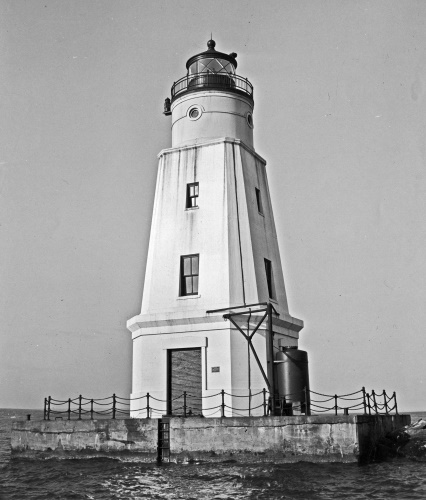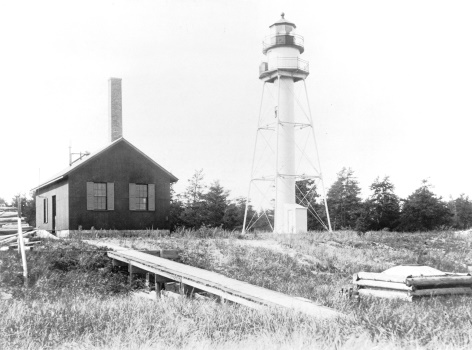| |
Surprise! You Are Now The Proud Owner…
Bob Mackreth
Originally published in Great Lakes Lightkeeepers' Association Beacon, Fall, 2015
 |
Ashland Breakwater Lighthouse, 1945
U.S Coast Guard Photo
|
On July 11, 2015, the National Park Service celebrated the addition of the Ashland, Wisconsin, Breakwater Lighthouse to the Apostle Islands National Lakeshore. Thanks to a bipartisan effort by the area's Republican Congressman and Democratic Senator, the park boundaries were redrawn ever-so-slightly to take in the 100-year old tower, and ownership of the structure transferred from the U.S. Coast Guard to the NPS. It was quite the occasion: there was live music, free food and drink for the crowd, and speeches by politicians and officials congratulating each other for the achievement.
The last time the National Park Service added to their stock of Apostle Islands lighthouses, the event was considerably quieter. So quiet, in fact, that the NPS missed it entirely: incredibly, the agency spent nearly four years oblivious to the fact that an act of Congress had given the park ownership of not one, but five light towers.
When the Apostle Islands National Lakeshore was established in 1970, the park boundaries incorporated five light stations making up the major portion of what has come to be known as "the largest and finest single collection of lighthouses in the country." However, ownership of the buildings did not always come along with title to the land beneath them. For the first two decades of the park's existence, management and preservation of the lighthouses took place under a hodge-podge of agreements between the NPS and the Coast Guard. Complicating life was the well-known fact that the two agencies did not always see eye-to-eye on issues of historic preservation. By 1986, the two agencies had settled into a workable, if sometimes tense, modus vivendi, whose precise arrangements were different at each of the five island light stations.
Life was simple at Raspberry Island. Since the Coast Guard had long ago moved the beacon to a pole outside the historic lighthouse, the agency had no objection to handing off the structure to the new park. At Sand Island, the situation was only slightly more complex. Some time around 1933, the Lighthouse Service had moved the automated station's acetylene lamp from the lighthouse itself to a skeletal steel tower erected out in front. In 1937, the U.S. Forest Service took ownership of the sandstone lighthouse, then several years after the National Lakeshore was established, turned it over to the NPS with a minimum of fuss. Things were more complicated at Michigan Island, where two lighthouses with different owners sat side by side. The 1856 stone lighthouse, which had been dark for decades, belonged to the NPS, but the adjacent cast-iron tower, which took over its predecessor's duties in 1929, remained in Coast Guard ownership. Communication between the agencies was erratic. In 1972, the Coast Guard replaced the active beacon's Fresnel lens with more modern apparatus, then a year later removed all the glass panes from the lantern, reportedly in hopes of reducing troublesome reflections from the new lamp. A fortunate chance encounter over beers between a young park ranger and his Coast Guard neighbors led to preservation of the lens, now on display at the park's Bayfield headquarters, but the window-pane issue proved more troublesome. Nearly twenty years later, a new Coast Guard commander wrote to the National Lakeshore complaining that rainwater entering the open tower was causing it to rust; the park superintendent replied with badly-disguised annoyance, reminding his counterpart just which agency's fault that was. At the far edges of the island chain, all seemed well at Outer Island, where the agencies reached an accommodation whereby NPS workers performed extensive restoration work on the Coast Guard-owned tower, subsidized in part by funds from the latter agency. The situation at Devils Island was not nearly so amicable, however, and at the close of the park's second decade, the two agencies came into open conflict over the Coast Guard's unilateral decision to remove the tower's third-order lens-the last lens remaining in an Apostle Islands light-- for "safekeeping" in a Michigan warehouse. 
"New LaPointe" Light Tower, 1915
U.S. Lighthouse Service Photo
Before that happened, though, a new law changed the rules of the game. In 1986, the U.S. Congress added an additional island to the twenty that made up the national park: the skinny sandbar known as Long Island. Separating Chequamegon Bay from the open lake, Long Island was the site of not one, but three lighthouses: the archipelago's second-oldest beacon was built there in 1858, then replaced in the 1890s by two towers: the Chequamegon Point light at the island's tip, and the larger New LaPointe light nearly a mile to the east.
Incorporating Long Island into the boundaries only added 200 acres to the National Lakeshore, but the language of the bill contained a hidden bombshell: "Notwithstanding any other provision of law, any Federal property located within the boundaries of the Lakeshore is hereby transferred… to the administrative jurisdiction of the Secretary (of the Interior) for the purposes of the Lakeshore. Provided, however, that the United States Coast Guard may retain a right to utilize a portion of such land and facilities as navigational aids so long as may be required." In other words, from that point on, the Coast Guard would be nothing more than a tenant in lighthouses belonging to the National Park Service.
Continue to next page
|
|